In Berio’s sinfonia, he has regular instruments from the classical era but what makes it unusual are the voices. He uses voices in a two way matter similar to instruments. Berio has the bass voices singing a specific type of lyrics and the higher voices saying another thing in a polyphonic way.
Month: May 2017
Vienna Art Orchestra – From No Time To Rag Time
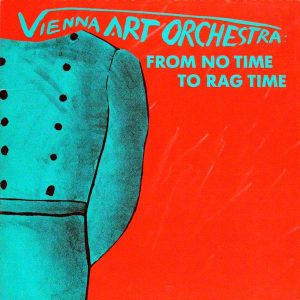
The Vienna Art Orchestra was a phenomenal ensemble led by saxophonist, arranger and composer Mathias Ruegg. The original lineup changed over the years, eventually to form a group made up of a jazz big band, with added percussion and woodwind instruments found in the symphonic orchestra. From No Time To Rag Time was the first record I ever heard of them, and right away my first impression was that it is highly virtuosic and advanced music. I was amazed by the level of musicianship from all the players, the complexity of the solos and the interesting orchestration and arrangements.
The opening track, titled Variations about n 508-10 (4g) is a quirky cacophony of sounds that tips the hat on different genres. The piece opens with a fast and complicated line featuring a soprano singer, a xylophone and a woodwind instrument (possibly a clarinet) all playing in unison. The opening phrase leads to a more straightforward section that starts with a canon played by the oboe (imitating a typical jazz walking bass line) then the vocalist enters, and then the trumpet plays a short solo while the percussion provides a steady swing beat. The band goes back to the opening phrase and again is followed by the B section with the walking bass line and trumpet solo. It then repeats back to the first phrase, but this time the drum set plays hits and fills that come unexpectedly, bringing in the band to a chaotic section with a lot of playing by various instruments in full swing mode. Suddenly, the band stops and the piano plays a complex and lengthy solo, with heavy dissonances throughout. After the piano solo the band comes in again, and the saxophone takes the next solo while the ensemble provides support. The piece ends with the vocalist and the trumpet trading lines. We can recognize the influence of jazz and the sound of the swing big bands flirting with classical music, postmodernism aesthetics, atonality and free jazz.
The next track is a slower, cool jazzy tune called Variations About Keep Your Heart Right. 5 of the 8 tracks in this album have the word “Variations” in it, which makes me wonder if indeed they are variations on previous compositions either by the bandleader or by other composers. The saxophones are featured predominantly and there are also memorable vocal lines in unison with the band. After the first dual saxophone solos, the band returns to the opening theme but then shifts gears to a faster tempo, setting up the mood for a cool trombone solo. Following the t-bone comes another saxophone solo, this time longer and without accompaniment, and then the big band kicks in at the same bright tempo as before. Finally, the coda has ensemble hits that are punched by the drum set and has an interesting blend of the different ensemble sections and timbres of the orchestra.
The 3rd track, Variations About Silence, features the soprano, exploring more of the free jazz aesthetics are. Next, the tune Un Poco Loco has more of a latin feel, with lively beats using cowbells and latin percussion and horn lines that have swing phrasing but also a bit of a Spanish flavor. The whole piece is played with a steady upbeat tempo, which is a nice break from the mostly swung rhythm of the previous tracks.
As with many jazz records, this album includes a lyrical jazz ballad called Variations About a Liberate Proposal. The drummer plays with brushes and adds nice effects on the cymbals while the percussionist enhances the tune with different effects using an array of instruments, including gongs, bells, chimes, jingles, maracas and other toys. But the saxophone is the main protagonist here, playing the main themes and lengthy solos while the band lays down the accompaniment. At the very end, the tempo is sped up and the piece ends with complicated phrases played by the saxophone and sung by the soprano in unison, a common trait used throughout the album.
From No Time To Rag Time is an interesting blend of contrasting schools and genres that in my opinion works well in exploring something new, sort of like the Third Stream concept does. This is a record that takes time to digest and thoroughly appreciate its nuances. It is a great piece of art and certainly one of my favorite big band crossover experiments.
Esperanza Spalding – Festival de Jazz de Vitoria-Gasteiz 2012
Born in Portland, Oregon, the great Esperanza Spalding a female bassist and singer performs in ” Festival de jazz de Vitoria – Gasteiz” located in Vitoria, Spain. Esperanza Spalding plays upright bass and also electric bass. She is one of the female bassist that I’ve witness who has mastered the bass. First song of the festival is titled, ” hold on me”. The beginning of the piece begins with Spalding singing great melodies and lyrics with also responding with her upright. Her communications with musicians show how great discipline they have to work with her singing and not playing over her. She ends the first piece with a long voice line which surprised the audience with her great voice. Spalding has great Melisma skills with her voice which leads her voice to what ever shes playing on the bass. Her second piece “smile like that” it’s more of a modern jazz piece which starts out with a Bossa style and leads into a modern jazzy pop tune, like Herbie Hancock. The piece sounds very dissonant on the solo. Soloing on dissonant changes can be difficult for a musician to lose focus on the changes. Her winds section really take their solos to a new level. And the best part is, the bass just follows along with whats happening. Jeff Lee Johnson is the guitar and he sounds very versatile the way he switches from a jazz sound to a heavy rock sound. Every time he changes the sound, he also changes the melodic style of his performance and solos. The third piece is titled, ” Cinnamon Tree” and she grabs her electric bass which for me is just amazing. Her tone on the electric bass is incredible and just for a fact, finding a great tone on the electric is sometimes complicated. Her bass sounds as if she were to use the neck pickup, but shes adding a lot of rhythmic elements that sound like she was influenced by Jaco a bit. On the ending solo, Jeff Lee Johnson takes a solo and he pulls out his blues sound which could influenced by B.B King or other blues guitarist. This piece mostly focuses on Johnson’s guitar solo throughout the end. Spalding’s wind players are also versatile in which they do chorus lines while the solos are happening. Her fourth piece is titled, “Black Gold” which starts with a gospel style. This piece features Spalding and her trumpet player Igmar Thomas on voice. Her fifth piece “Radio Song” could be compared to soul bands like James Brown but incorporated with jazz. On that same piece, Spalding announces all of her musicians that performed on this festival which are, Jef Lee Johnson – guitar, Leo Genovese – piano, keyboards, Jeff Galindo – trombone, Corey King – trombone, Daniel Blake – tenor sax, Aaron Burnett – tenor sax, Tia Fuller – alto sax, Igmar Thomas – trumpet, Lyndon Rochelle – drums, and Chris Turner – vocals. Esperanza Spalding has been one of the female bass players to play seriously and professional. Her communication throughout her instrument is something that other players could take into consideration and use it for their performance as well. https://www.youtube.com/watch?v=3Js_PDyH71g
Alarm Will Sound Performs Aphex Twin and Music from ‘Hannibal’
On May 13, 2017, Alarm Will Sound performed at Merkin Concert hall for 2017 Ecstatic Music Festival. They totally performed five tunes: Aphex Twin -minipops 67, Tyondai Braxton – common Fate, Brain Reitzell -Hannibal (Selection from the TV Soundtrack).
Alarm Will Sound is a not name of recording company, it is a name of chamber orchestra. It has twenty member and they focusses on recordings and performances of contemporary classical music. Many people describes their perfomances as “equal parts exuberance, nonchalance and virtuosity.

They’ve worked and arranged Aphex Twin music for 15 years. They love Aphex Twin music so much. They’ve found challenges from Aphex Twin music that how to imitate the electronic sounds of using musical instruments. Their achievement and challenges was succeed as you hear their performance of Aphex Twin.
First tune that they performed was great. I compared both original track by Aphex Twin and theirs. They couldn’t imitate 100 % sounds of music but, they performed almost same as original track. I think it is very difficult to find the electronic sounds from acoustic instruments, I was very surprised their efforts. They imitated sound of synth bass to use brass, electric snare drum to use clapping, some kind of wind sound to use violins, etc. They used original voices from Aphex Twin.
Common Fate by Tyondai Braxton is 21 minutes music. Tyondai Braxton is an American composer and musician. Mostly he composes music like New Music and experimental rock. I couldn’t find much information about this music. What I observed this music is very simple and repetition melody each movements?
The next tune, Brian Reitzell – Hannibal (Selections from the TV Soundtrack). It is about 15 minutes. They played sound track from Hannibal, is an American psychological thriller–horror television series developed by Bryan Fuller for NBC.

It sounded very similar as “Crumb, Black Angels, Ensemble Intercontemporain”. I think it is similar because both sounded horrifying and creepy. About 6 minutes of this tune, you can hear multiple percussions playing. It sounded atonal. I heard very funny sounds like from “Tom and Jerry” but I don’t know what that is. It has so many dynamic changes especially timpani.
‘
Norah Jones Live at the Baloise Session
Recognized Jazz singer Norah Jones performed at the Baloise Session music festival held in Basel, Switzerland on November 7, 2016. The concert was aired by the Arte channel on February, 2017. A fusion of styles as well as different genres were mixed in this concert highlight the vocal, piano and guitar talent of Norah. Her voice fits every genre of music and she certainly proves it by using these varieties in her live performances and recorded albums. In this particular performance, Norah uses her classical jazz style with fusions of blues and blue-eyed soul. There are also blends of country and pop in some of the pieces. Although is was not a virtuosic performance as we expect from a jazz concert, she pulled it off by the beautiful timbre of her voice, which has an excellent way of interpretation.
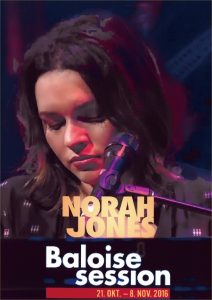
Norah begins the performance with “Day breaks“, a song that titles her last album released in October, 2016. A fusion of jazz harmony with a steady rock pop rhythm makes of this song an interesting piece. Perhaps the most relevant album of Norah’s career “Come away with me” have a series of songs people were expecting to hear. On the second track of this concert, she sings “I’ve got to see you again“, a fusion jazz piece that includes the mellow combination of musical factors that interpret the need to see the person she loves. A rhythm going constantly with a few syncopated chords from the piano and some motifs now and then, helps set the scene. An ambient guitar with doubles the piano solo in echo, a quiet bass almost silent, sets the platform for Norah’s voice to stand out. She puts the bluesy mellow tone in her vocal performance allowing the piece to be felt.
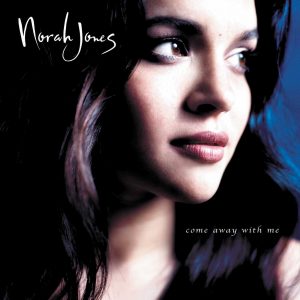
Jones performed other hits such as “Burn“, “Out on the Road“, “Tragedy“, “Sunrise“, “Don’t Know Why“, among others. This was a concert with moments of emotion and sparks but it was not 100% spectacular. Jones is not the most expressive person on stage which is particularity strange due to the sweetness of her voice. The other musicians were not great at all. There was no Jazz coming out of them. They sounded more like pop musicians than Jazz, which kills the flavor of it. She should’ve stick with one genre, either Jazz or Pop, but the mixture didn’t work in this case. In general it was pulled off thanks to her talent, but it could’ve been marvelous. Lots of fusions are arising nowadays, some of them work other don’t but it’s always good to explore new venues. The key element is having the right people to perform, because that will affect no matter how talent the artist is. Norah sounds way better in other performances and recordings, specially when she is accompanied by great musicians. Although this was not her best performance it does not devalue her talent. She is an amazing singer and musician and she shines specially when the instrumentation is limited. This lets her talent blossom.
https://www.youtube.com/watch?v=i8BOLObfKHU
Sounds of the World: A Synthesis of World Music, Sampling and Soundscapes
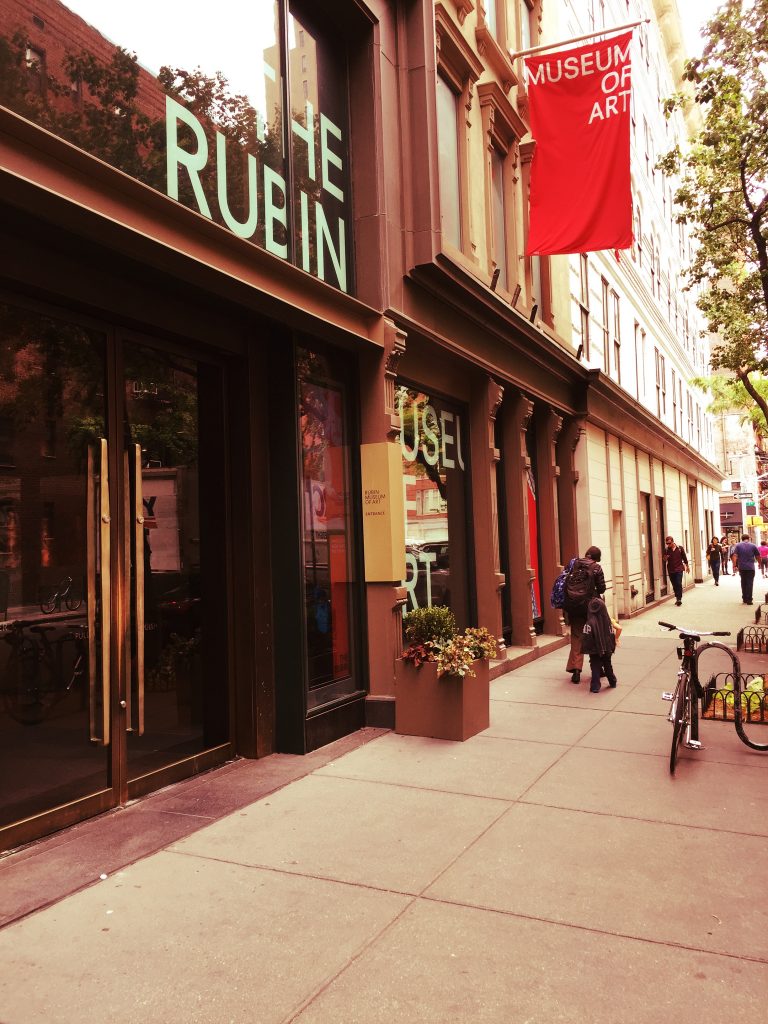
Inspired by Sacred Spaces, the exhibition held in the Rubin Museum of Art NYC, which explores the soundscapes of the Himalayas including their winds as well as the soundscapes of the most high located buddhist monasteries, I decided to take further the concept presented by the exhibition and explore a few sound concepts that are shown in the world today. As a manner of execution I am also including the concept of sampling. The reason is that thanks to the advancement of sampling technology, we can experience the perception of this sounds without leaving home. In this journey we will explore not only what this particular exhibition offers, but also how the world sounds and how the people of the world transmits music. During my visit I did some sampling myself in order to capture the sounds presented in the exhibition to share with you.
I am going to divide this study in 4 parts. The first part is going to include a review of the exhibition with sampled sounds of all the recordings shown there. Secondly, we will explore the sacred sounds of the world. This is going to be in relation to people around the world, how they project music in a perspective considered by them as sacred. Next we will explore culture expression through music by quickly analyzing how people make music around the world. Lastly, we will explore 4 natural soundscapes of the world, fascinating samples recorded in remote parts of earth. Note that every single audio, nor picture I’m sharing was not downloaded from the internet. They belong in part to sound libraries set for Kontakt, a virtual instrument that executes sampled material. These samples were rearranged, mixed and mastered by me, for the purpose of this study. So, I invite you to…
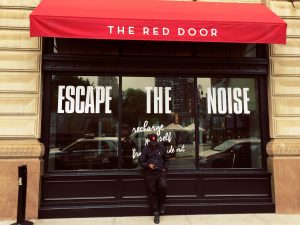
THE EXHIBITION
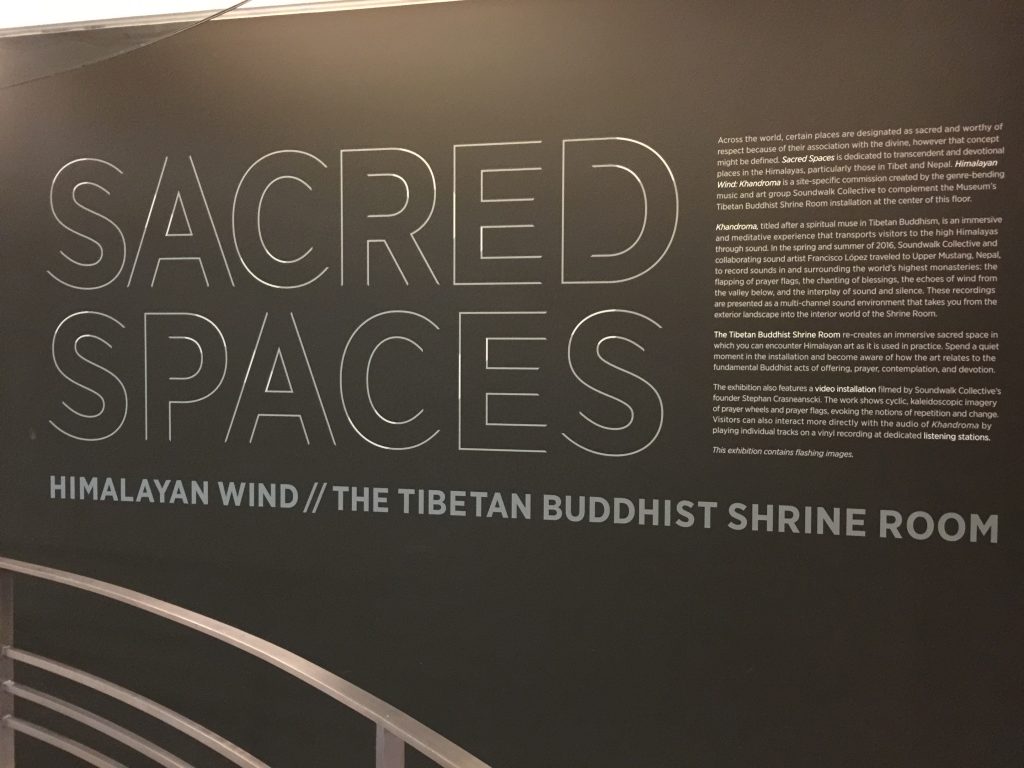
Not too much to see on the forth floor of the Rubin Museum, but a lot to sense. There are 4 different spaces that offers these recordings in order to sense them differently. The first one is a hallway with 2 screens projecting holograms. They have seats and headphones for people to sit, listen and watch while entering in a estate of meditation. At one end of the hallway there are 3 turntables with headphones for people to listen the recordings in vinyl.
HEADPHONES
HEADPHONES 2
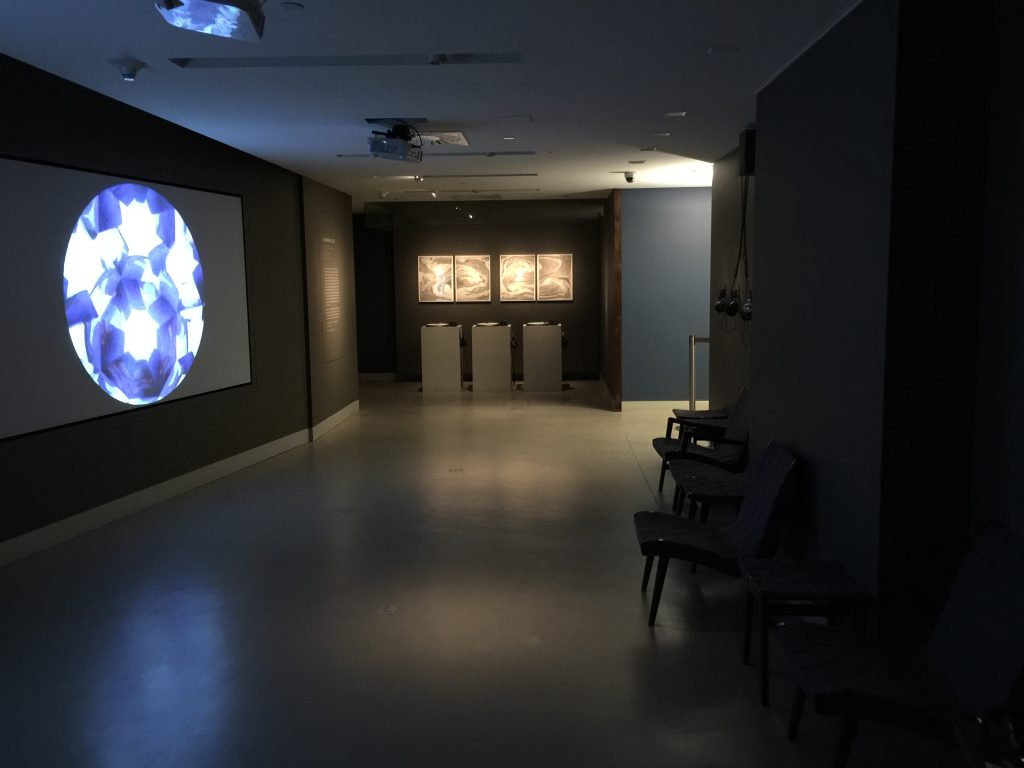
VINYL

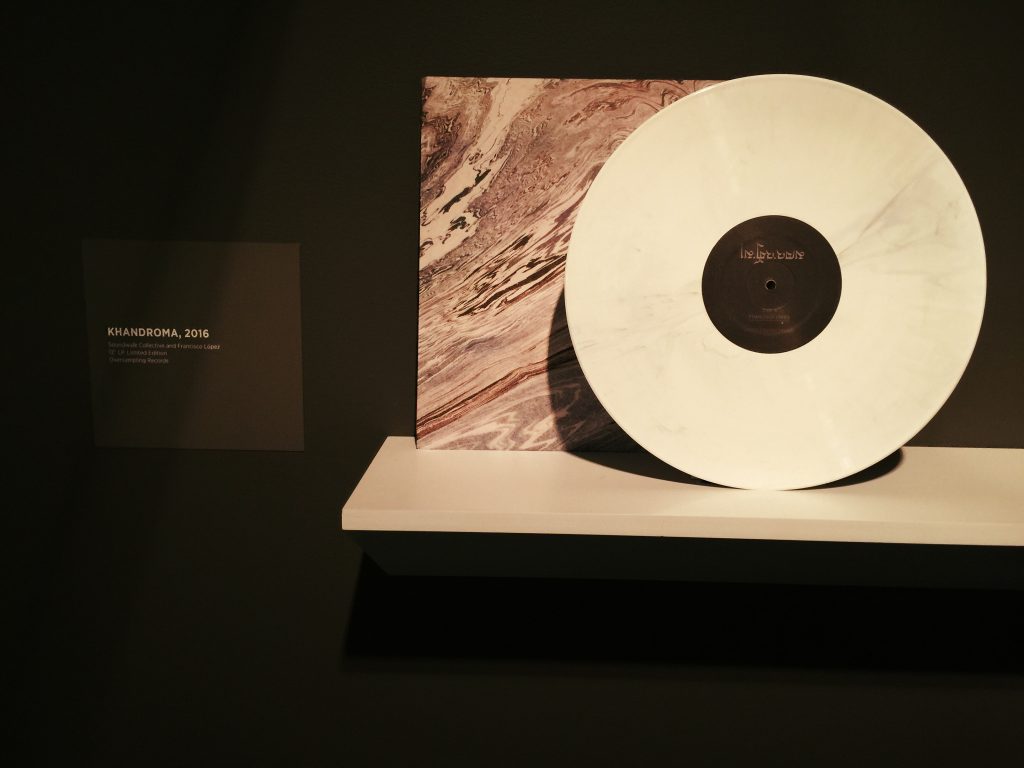
The next room is a the shrine room. This space was conditioned with elements of a buddhist prayer room. The sounds played there are the monastery sounds recorded in the Himalayas. The experience is interesting knowing that by only listening I felt cold. Maybe the sound makes that effect but it surely drives the senses to explore something different.

THE SHRINE ROOM
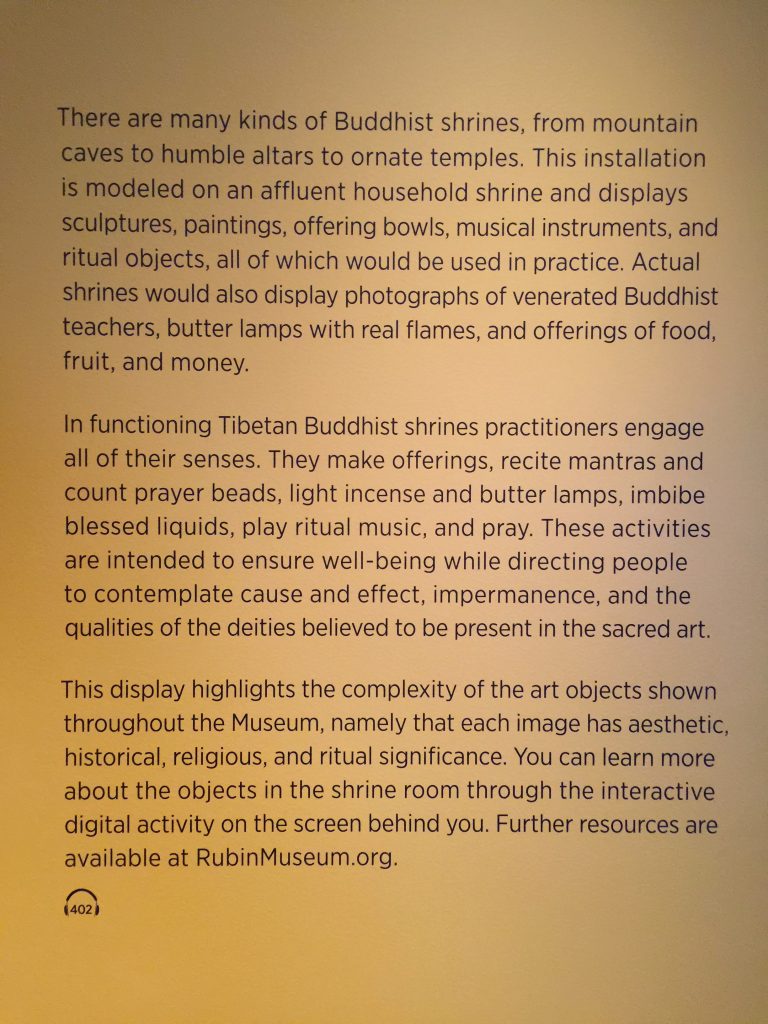
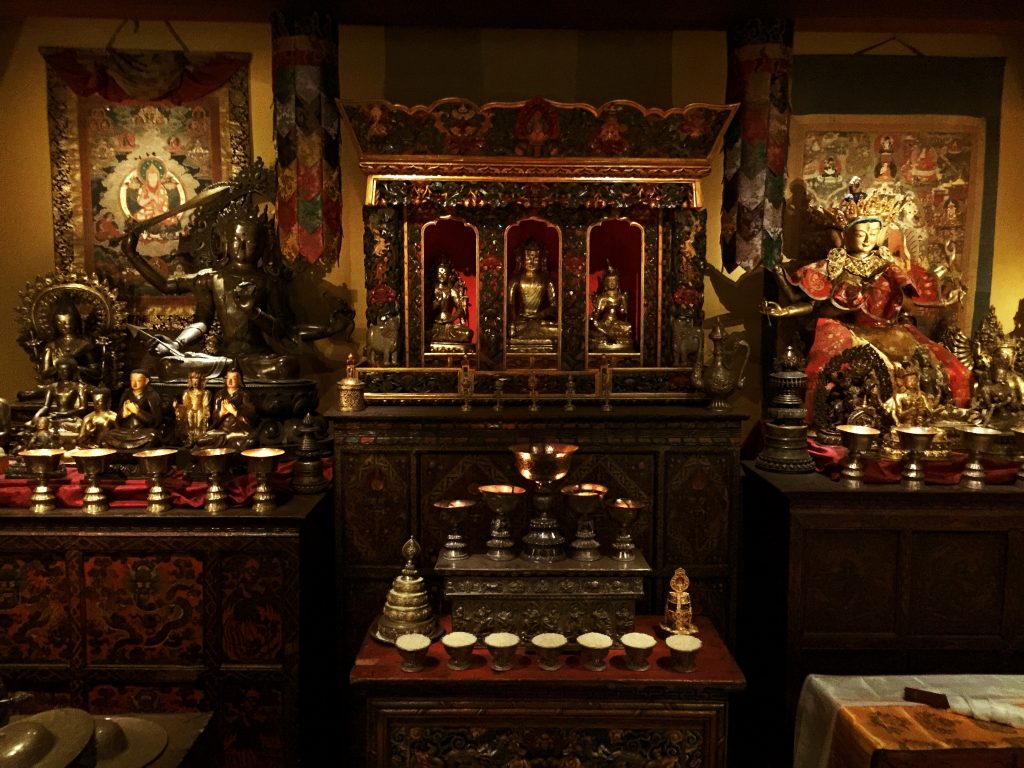
The most important part of the exhibition is a sound room conditioned and structured to play the sound recordings with sound proof capabilities. It offers 2 tower speakers one at each end and in between there are several studio monitors side by side playing the wind sounds. The main speakers play the soundscapes focused on closed spaces whereas the studio monitors play the open soundscapes environment.
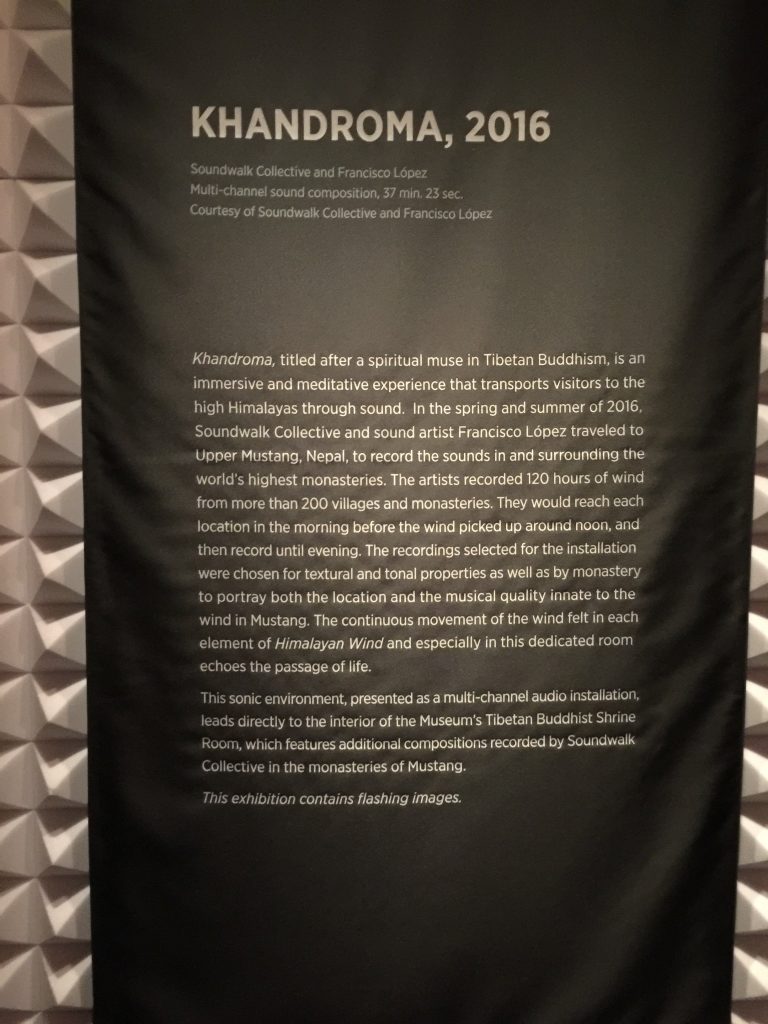
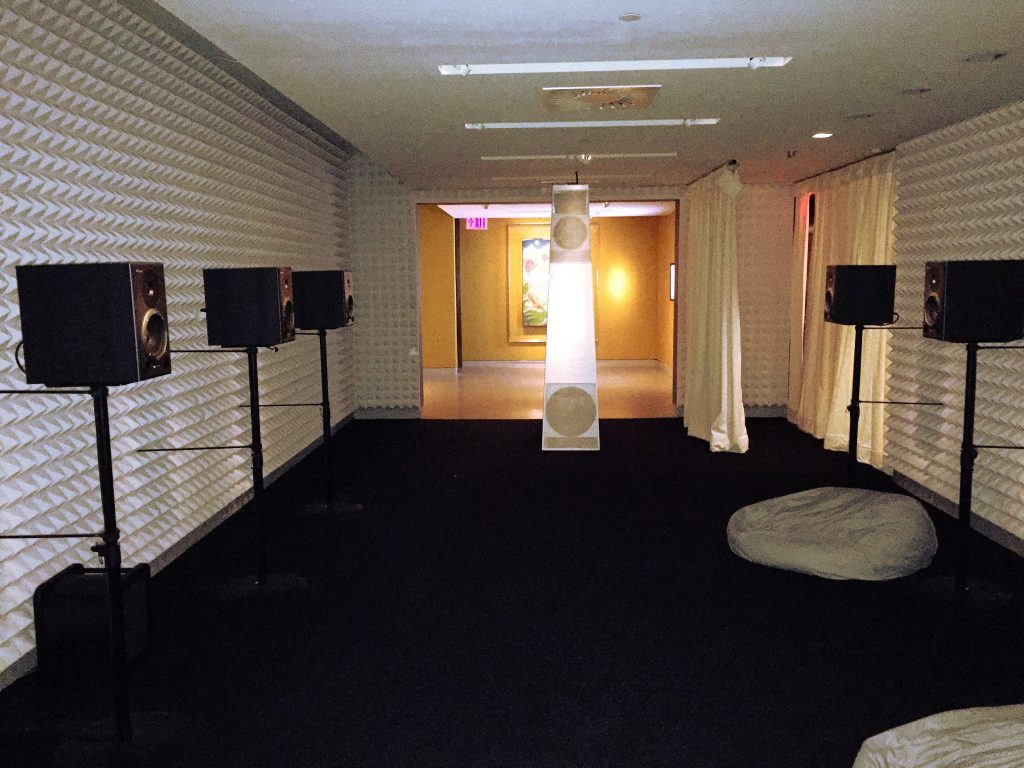
Front speaker
back speaker
side monitors
I managed to collect high quality samples from these devices thanks to my Zoom H6 Recorder which offers top professional quality sampling. This last sample of the exhibition was recorded while I walk thru the room side by side.
Walking
Although the exhibition name is Sacred Spaces, the soundscapes recordings relate more to open spaces rather than sacred places, that is why I think the title is not completely accurate and its more relating to religious disciplines such as meditation or yoga. On the bottom floors of the museum there are exhibitions with more visual content focusing more on the sacred aspects of these asian cultures. 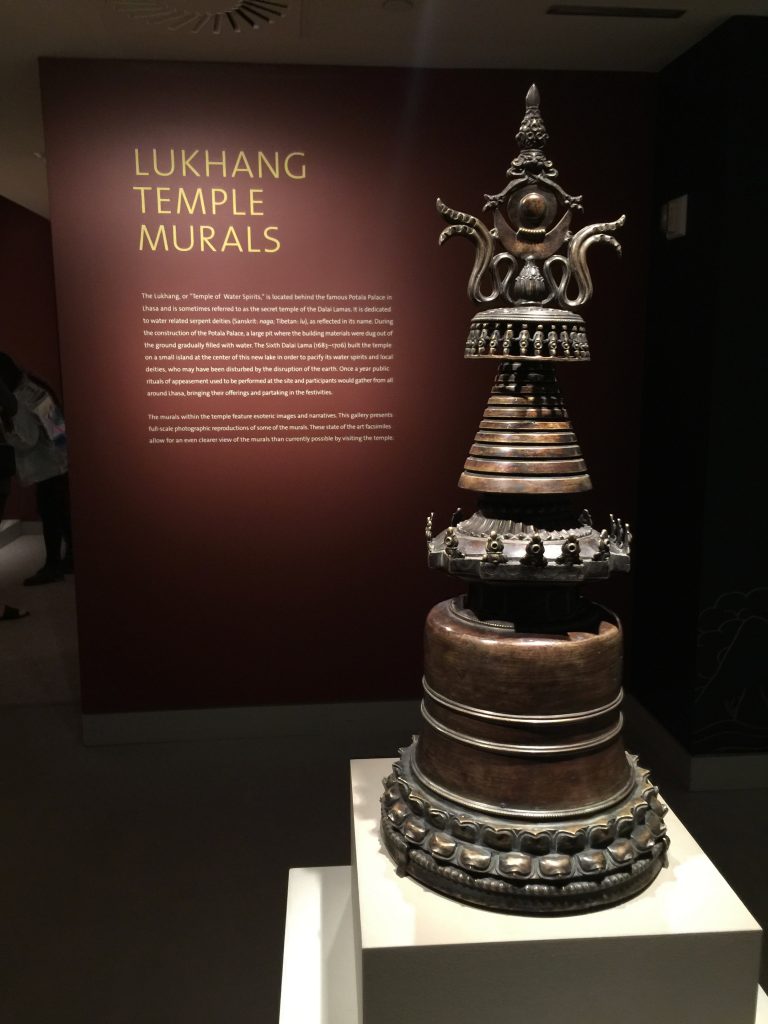
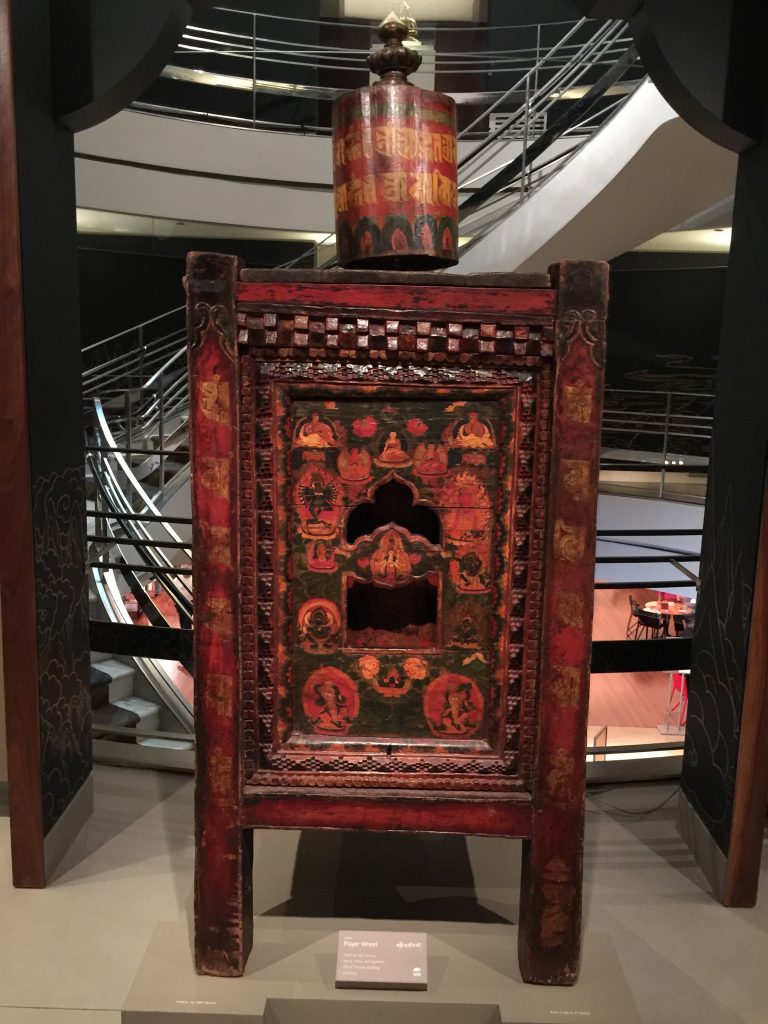
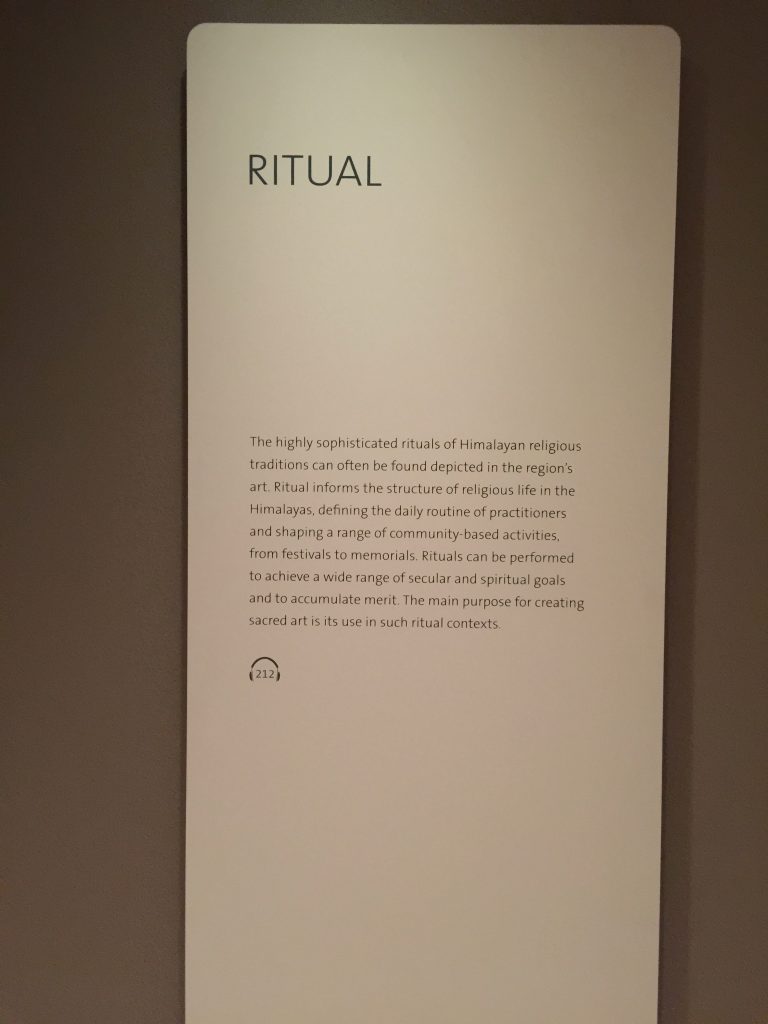
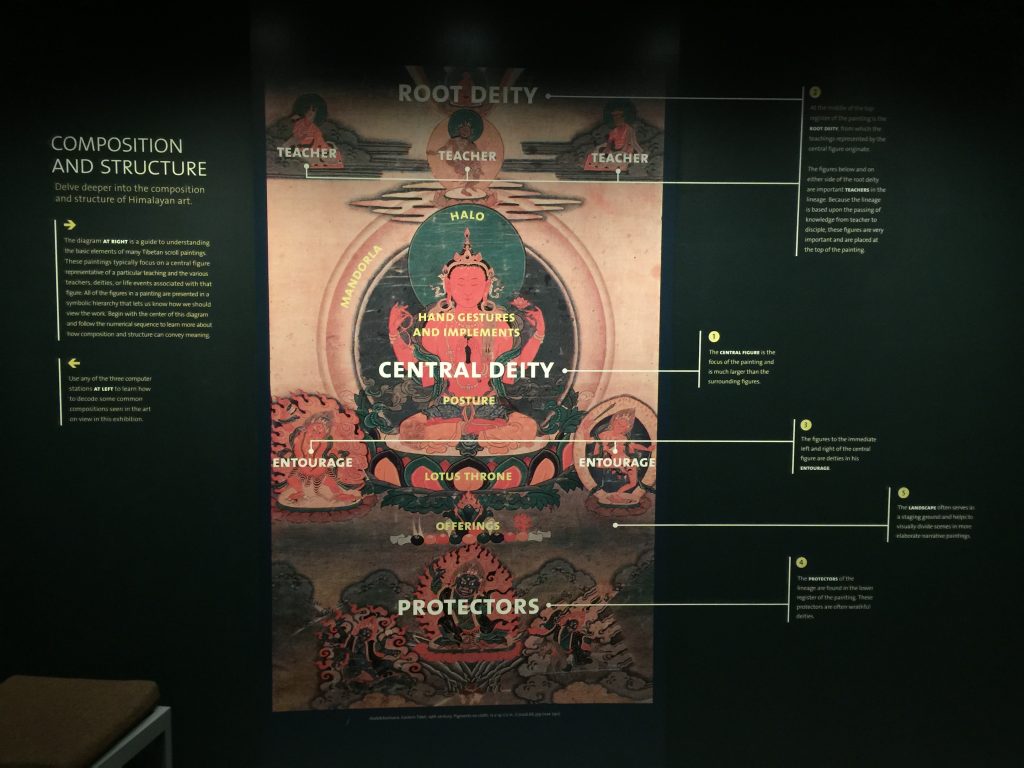
HOW PEOPLE WORSHIP
The world is a fascinating venue full of color and variety. People around it have different beliefs, credos and rituals. However, the all have one thing in common and that is music. This is an important element for every human being because it’s a way of expression. There are different religious practices and there are different sacred sounds. In this section, we will explore some of the sacred sounds around the world. How people sing or chant their sacred music in order to worship what they considered divine.
First of, in North America, the Native Americans chant their war and tribal chants. The following audio was sampled from an original Native chant in the United States.
Moving next to South America, more exactly Peru, a Quechua song worshiping Pachamama of the goddess Earth. The accompaniment is not part of the traditional ritual, but is was adapted in modern rituals.
Heading East to Europe we can find the Gregorian Chants and the Mystic Songs of the Roman Catholic Church.
Moving South to Africa, the Protestant Church reaches several parts of the continent, forming choirs of worship to Jesus.
In Malawi Africa a traditional tribal chant sang by a girl.
Moving to the Middle East an Israeli woman sings a traditional Jewish Psalm.
We will end this sacred journey with a sacred mantra.
HOW PEOPLE SING
Our next journey explores how people sing around the world. Popular music differs in cultures according to customs and languages. It is amazing how music sounds different as we move from place to place, maintaining and interest and admiration. All the music around the world is wonderful.
Let’s begin at the Caribbean with a Jamaican reggae. This excerpt contains the first half with only vocals and the rest with the accompaniment. Please focus on the vocal interpretation since this study is focused on vocal interpretation and soundscapes.
Moving to the Alps in Europe where the Swedish Yodel their famous folk music.
In Bulgaria a traditional folk song.
A beautiful traditional Ukrainian waltz.
In North Africa, Algerian hip hop artist and rapper sings a popular Algerian hiphop song.
Moving South to Cameroon a popular song with a Bossa feeling.
In Guinea, a traditional song.
Moving to Asia, a Turkish chant.
More to the Middle East, an Irani chant.
At the Northside of Far East Asia, a Mongolian quintet performs a traditional piece with drones and vocal percussive effects.
Moving South to China a duet performs a traditional piece.
Southwest China, a Balinese traditional song performed by Philippine singer.
HOW THE WORLD SOUNDS
This was a journey of sound and music exploration focusing on the soundscapes from places considered sacred. Then there was an analysis on how people uses music to practice religion and worship, ending on an exploration of traditional and popular music in around the world. Now we will end exploring 4 different soundscapes that are almost impossible to reach. Welcome to Geosonics. Geosonics is a sample library developed by English company Soniccouture. This library offers a huge library of samples recorded by one of the world’s leading recorders of wildlife and nature, Chris Watson. The first soundscape is ice and water. This particular example was recorded in the Icelandic glaciers south the North Pole.
Secondly, we will move north to the North Pole to catch the sounds of the polar winds.
In contrast with the freezing weather, this next soundscape was sampled in the humid swamps of Africa. The notorious sound in this example are the African frogs.
Finally, in the dangerous Australian Outback there is a system of wires of interconnection, This example shows how the wind hitting these wires make a particular sound.
Nick Vasallo – “The Moment Before Death Sretches on Forever, Like an Ocean of Time…”
Nick Vasallo is a young up and coming composer from California. He has written choral works, chamber music and pieces that experiment with electric guitars, bass and drumset that blends influences from classical music and death metal. “The Moment Before Death Stretches…” is a piece for chamber orchestra that calls for a variety of instruments, some of which use extended techniques, making good use of the timbral palette. The orchestration calls for: percussion (vibraphone, cymbals, concert toms) piano, strings (violin and cello) brass (trombone, baritone sax) woodwinds (oboe, flute) electric guitar, synthesizer and vocals.
The video starts with a stopwatch which serves as a guide for the musicians. There is no conductor, but each player has written cues indicating what and when to play. At the beginning we hear a very low pitch being played on the contrabass with a bow. Then, the percussionist also uses a bow to rub a key from the vibraphone, producing a piercing, high pitched sound. She adds cymbal effects while the contrabass keeps repeating the same note. The mass of sound starts intensifying and getting more and more dense with the addition of strings and what sounds like throat singing or a didgeridoo at a soft volume, possibly played on a synth or from a laptop computer. Afterwards, the pianist plays by herself, repeating the same pitch the contrabass was playing but creating a very cool effect that sounds sort of like a reverb. This is achieved by pressing some of the piano keys halfway, creating sympathetic resonance. All of this makes it sound even more ominous, anticipating the huge sound that’s about to arrive. The pianist plays in unison with the percussionist with one hand and with the other rubs a screwdriver against the piano strings. Then, a throbbing, steady and low pitched sound makes an appearance and introduces more string instruments which start playing along with the electronic low end sound. The ensemble starts building up, playing faster and louder, with the percussion pounding on the concert toms until the music erupts in loud, steady, slow attacks. In this section we hear brass, strings, percussion and piano along with the electronic low end. This part reminds me of the suspenseful feeling used by many composers in movie trailers.
The next section begins with the piano playing fast repeated notes in octaves for a brief moment and then comes to a halt. The electric guitar makes an entrance by itself, and then more of the vibraphone bowing before we hear delicate singing by female vocalists with the strings playing long notes, getting louder and doing glissando up the instrument. Suddenly, the throbbing low end sound is played again by the brass on the same pitch, while a flute plays fast flurries and the percussionist plays fast, loud and aggressively on the concert toms. The ensemble stops suddenly, leaving only a faint sound lingering, only to begin again on a loud tutti but this time on a different pitch. At this point, the shift in pitch feels like we have arrived to a climactic resolution, with the brass providing the low end and the piano playing rapid notes in octaves, while the strings play tremolos and trills and the soprano sings high notes with vibrato technique. I would compare this section to a fermata at the end of a concerto. This part is cut off abruptly, giving us a nice contrast, and the piece ends with a sort of codetta that has very soft singing by the alto, along with violin and cello holding long notes for a few seconds until the piece comes to an end.
The piece has no formal bar lines, melodies or motifs, or even a clear structural scheme. Rather it is more of an experiment on timbre, sound combinations and pure expression.
In the attached link we can see a performance recorded by Wild Rumpus, a chamber ensemble that focuses on music from living composers.
For more information, check out the websites of the ensemble and the composer:
www.nickvasallo.com
www.wildrumpus.org
The website where I originally found this music is:
www.newmusicusa.org
For Massas by Viegas Pellerin Corda Orrù
I follow an experimental music blog on blogspot called Caliper Music. As I was searching for a recording to write about, I came across this really interesting piece called For Massas by Viegas Pellerin Corda Orrù (João Pedro Viegas, Guy-Frank Pellerin, Silvia Corda, and Adriano Orrù). The artists who created this piece are all trained jazz musicians with an interest in radical idea of free improvisation. Free improvisation is a musical technique in which the musician, or in this case musicians, improvise with no rules or logical precedent. Some people refer to free improvisation as a genre, but there is no logical technical music connection between any one piece. But it is arguable that the musical process constitutes the genre. I believe that it is a musical school like modernism or “post-modernism” in that the way you think about it connects the ideas. But it is also hard to classify recent experimental music because we lack the understanding of historical context that we use to classify music of the past.
For Massas was dedicated to the friend and supporter of the collaborators Paulo Albano, nicknamed Massas, who died shortly after the recording of the improvisational session. Conceived using this technique of free improvisation, For Massas was recorded live at Livraria Ler Devagar (in Lisbon, Portugal) on May 14th, 2015. I believe the location is a bookstore and experimental music space for artists in the area. Released on Pan y Rosas on May 2nd, the recording features João Pedro Viegas on bass clarinet, Guy-Frank Pellerin on soprano and tenor sax, Silvia Corda on piano, and Adriano Orrù on the double bass. The four tracks on the recording are La prima frase (the first sentance), notre réponse (our response), Massas diz mais Música (Massas says more music) and Encore. In the recording you can hear how the instrumentalists use a combination of traditional and extended performance techniques. This is especially apparent in Silvia Corda contribution on piano. You can hear her play traditionally but also pluck and scratch the strings on the inside of the piano, and strike the wooden part of the piano for a percussive effect. Adriano Orrù uses his instrument similarly, running his nails up and down the strings and using the body to create new percussive sounds. Also, he often uses the Bartók pizz technique as well as the slapping strings technique commonly used in Jazz and blues music. The woodwinds use some experimental performance techniques as well, but are limited in comparison. I really enjoyed when Pellerin slowed his breath enough on the tenor sax and created a vibrato with his reed.
The artist start off kind of slowly, as if they are trying to get a feel for the direction of the where the improvisation was going. Similar to when we tried the indeterminate singing pieces in class. But after about a minute they became a more cohesive unit. You can tell the instrumentalists are really listening to each other by their use of dynamics, empty space and layering. Certain parts of the music have more color while others feature a single instrument. This is similar to Jazz styles where some instruments will stop playing while one takes a solo. The result is this really interesting atonal piece, that juxtaposes space with sound and chaos. Music like this is really interesting to me because of how unique it is to that certain point in time. It evokes a visceral reaction, and forces me to really think introspectively. I think that is the point of it, there is no theme or motiff to hold onto for reference. It displaces and isolates the listener, partially because its not “enjoyable” in the traditional sense but also because there isn’t a single thread that can be followed. This isn’t the kind of music you can get lost in, or analyze. It isn’t for everyone, but I was drawn to it for some reason. Whether it was because I needed something new to hear, or because I needed something that made me think about myself, I am glad I found it. If you enjoy finding new music I suggest following Caliper Music if you aren’t already. I will definitely be looking out for these artists (short bios in hyperlink) in the future and you should too!
Also here is a link to the recording on the blog if you would prefer not to download a zip file: http://calipermusic.blogspot.com/2017/05/viegas-pellerin-corda-orru-for-massas.html
Universal Melody Brass Band
I went to see the Universal Melody Brass Band at The Stone curated by Steven Bernstein. Finding the venue was an experience of its own. From the outside the Stone looks like an abandoned shop; and the only thing that informs you that you have come to the right place is a bumper sticker on the door. Once inside you’ll see how small the venue really is. Chairs are pushed and cramped together surrounding a small circle of instruments and music stands, and by the time I arrived it was almost full. But none of that mattered once they began to play.
Run by Steven Bernstein (playing trumpet), Universal Melody Brass Band also features Frank London (trumpet), Art Baron (trombone), Curtis Fowlkes (trombone), Matt Darrio (sax), Oscar Noriega (sax), Marcus Rojaz (tuba) and Billy Martin (drums). They played a variety of Jazz favorites as well as original compositions by Steven Bernstein. Unfortunately there was no programs, cell phone use was prohibited and the venue was very dark so I couldn’t write down the names of any the pieces performed. However, one piece that really interested me was one of these original compositions. It was heavily influenced by Slavic music, which is similar in its use of modes. But because it was a brass band the instrumentation created a musical juxtaposition. A brass band in such a small space created another surprising juxtaposition. At first this big sound was quite jarring and hard to process. However, the sound soon washed over me and the effect was that the audience became one with the space. Being so close to the musician and on the same plane created an intimacy that can’t be replicated in a recital hall or on a stage. I actually felt displaced from my body during certain pieces because I was so caught up in the music, especially during the piece I mentioned before. In such a space with such a big band, you might expect that the soloist might be hard to hear but Bernstein managed to arrange the pieces with such a balance and fluidity that I couldn’t even hear when the other instruments backed off and came back in.
This group was also different because instead of having one or two main soloists, all of the musicians were virtuoso soloists on their respective instruments. And each musician had their own style of improvising which made for these really distinct transitions between solos. While the trumpets and sax solos were all fun to listen to, what really caught my eye was Marcus Rojaz on the tuba. Due to the nature of such a large instrument continuously fast moving passages are nearly impossible. That being said Rojaz combats that quality by creating these harmonically complex improvisations often sharpening the forth scale degree and flattening the 6th unexpectedly. And rather than playing long held out notes, or slower moving continuous passages, he uses the negative space (rests) to create more interesting rhythmic phrases. The trombone player Art Baron used a similar rhythmic style, but also incorporated quick slides into his improvisations. Bernstein played mainly a valved trumpet but also had a slide trumpet on certain songs. When he took solos on the slide trumpet he combined the fast moving phrasing common to the trumpet with fun glissandi.
Overall going to see the Universal Melody brass band was a treat. I would definitely recommend anyone to go and see them if they are ever playing in New York City again. However, if you do go you should definitely find a venue that is in a smaller space. I would have definitely enjoyed watching the group on a stage, but it would have lacked the intimacy that I experienced at The Stone. And in terms of a venue, if there is any experimental group or artist you would like to see, check out The Stone to see if they are playing. Trust me, the venue is an amazing experience of its own. Just make sure that when you go that you bring $20 in cash. Tickets are not available in advance.
Create Your Personal Website: Tuesday May 30
 You can create a personal website very easily using the same tools we used this semester for our course blog. And your site doesn’t have to be a blog: it can be an “electronic press kit”, a professional resume, or a place to promote your music and help people learn what you have to offer.
You can create a personal website very easily using the same tools we used this semester for our course blog. And your site doesn’t have to be a blog: it can be an “electronic press kit”, a professional resume, or a place to promote your music and help people learn what you have to offer.
If you’d like to learn how to use WordPress to build your website, come to the workshop on Tuesday, May 30 at 1:00pm. We’ll work once again in MU-412, the computer lab. I’ll walk you through the basics of WordPress site building and show you some tools that will help you create a professional public image.

